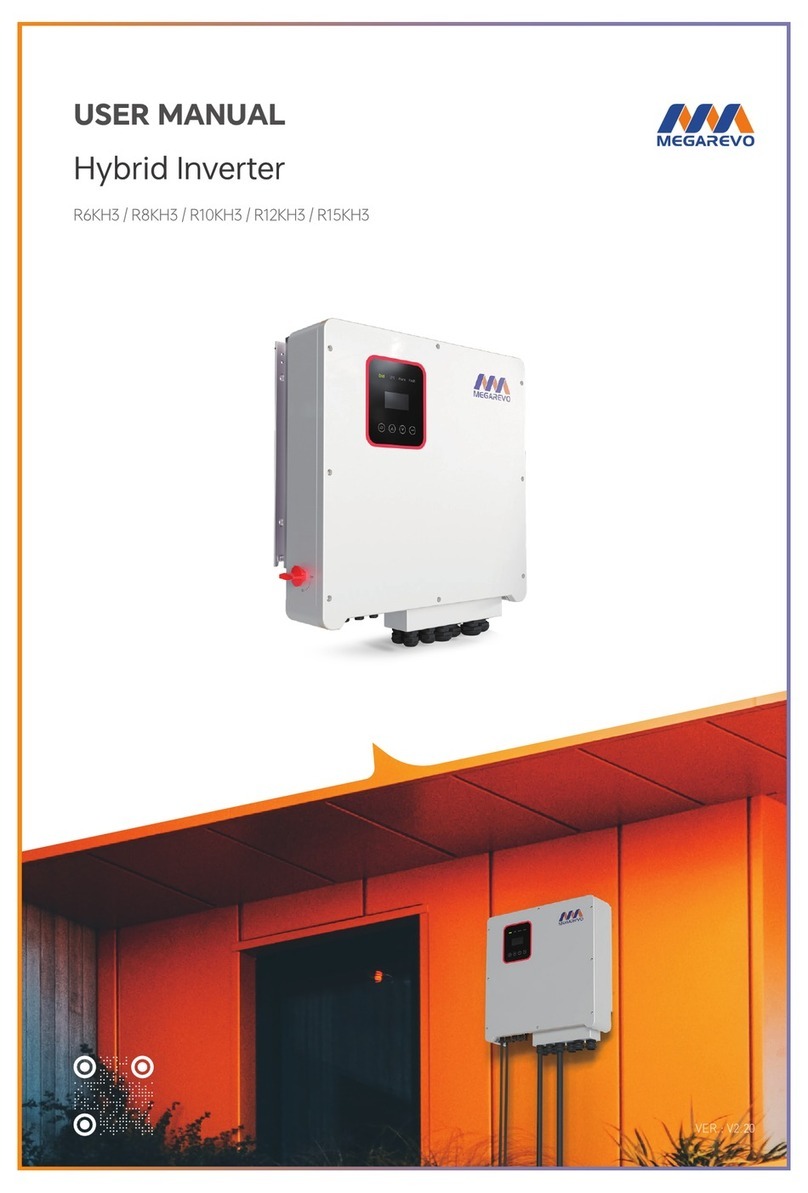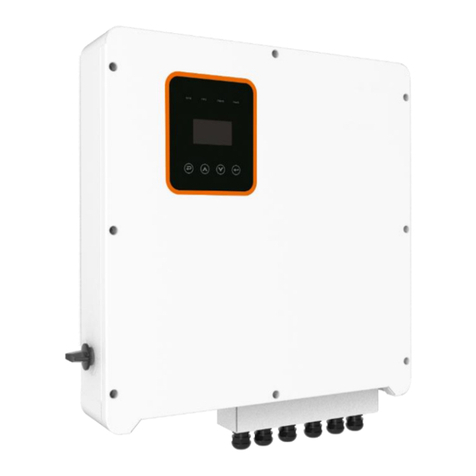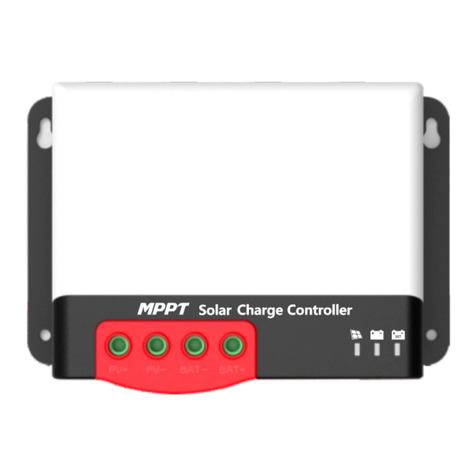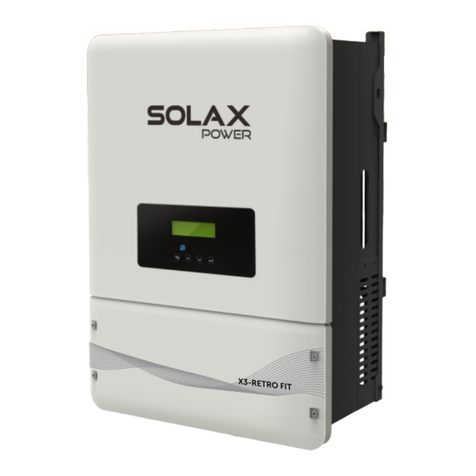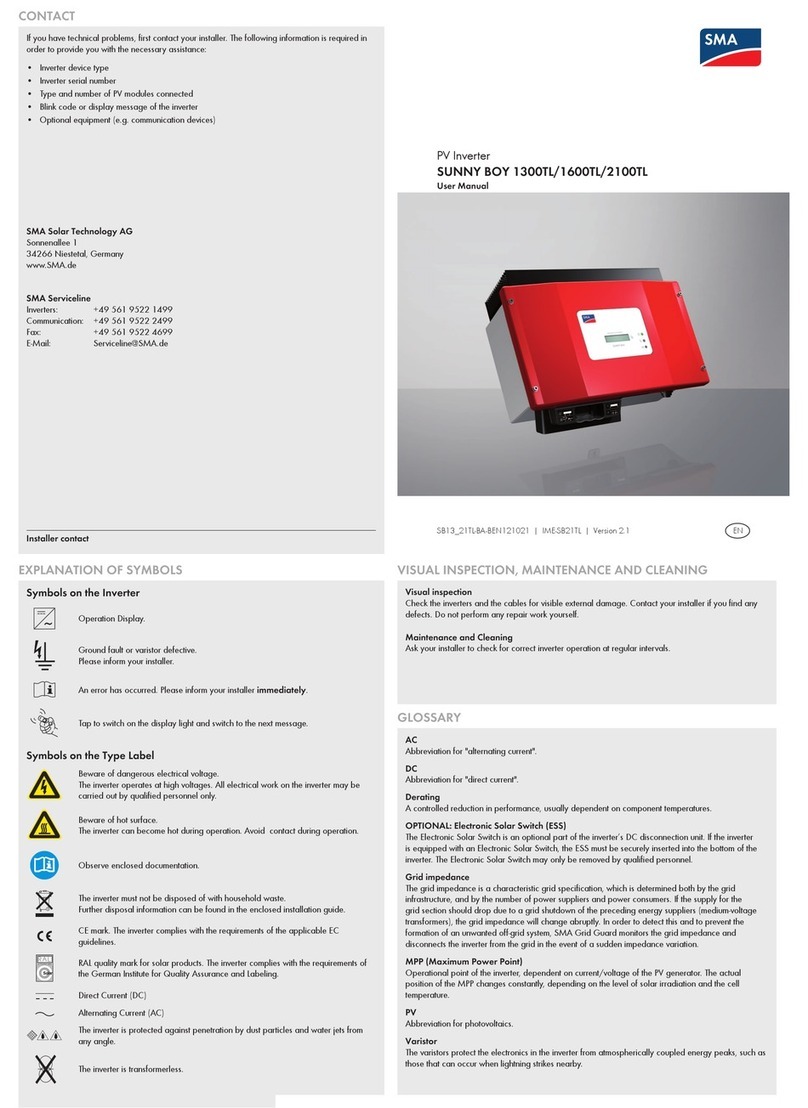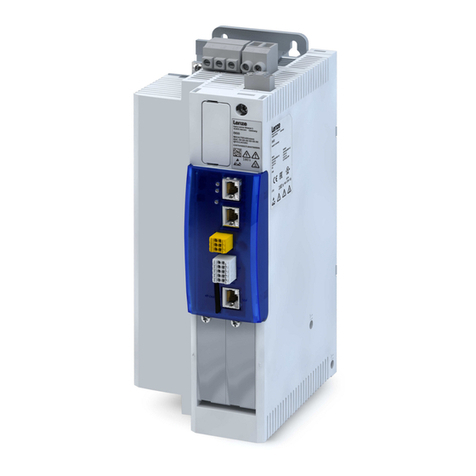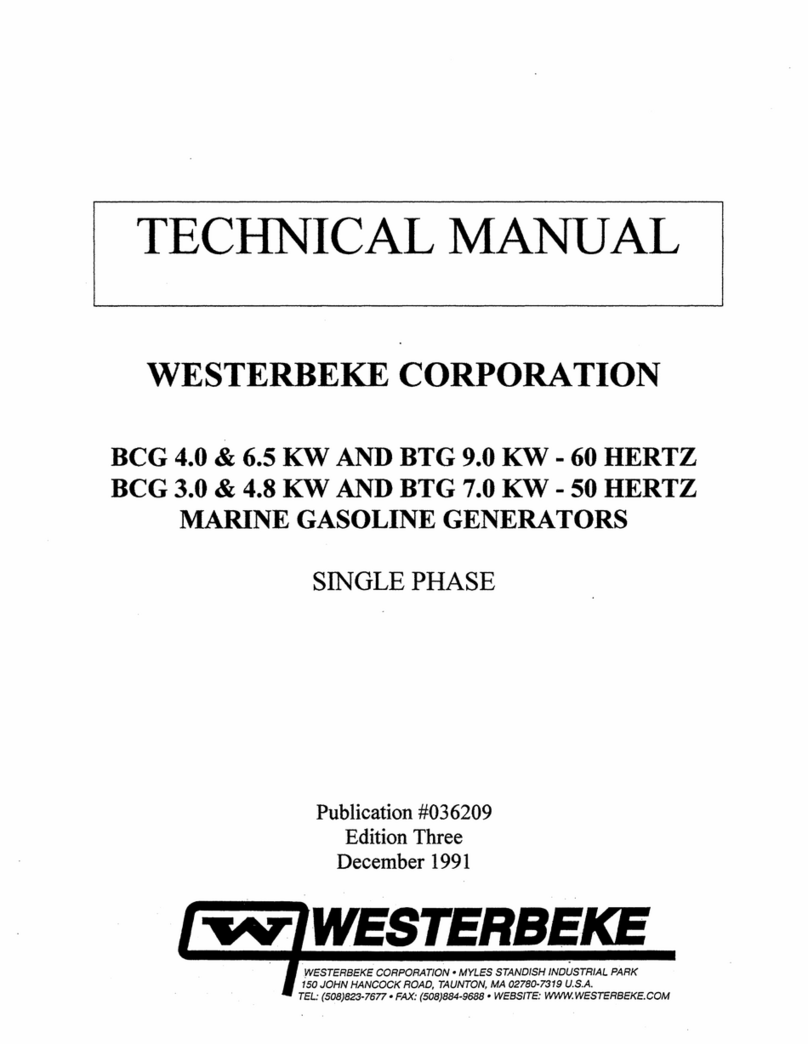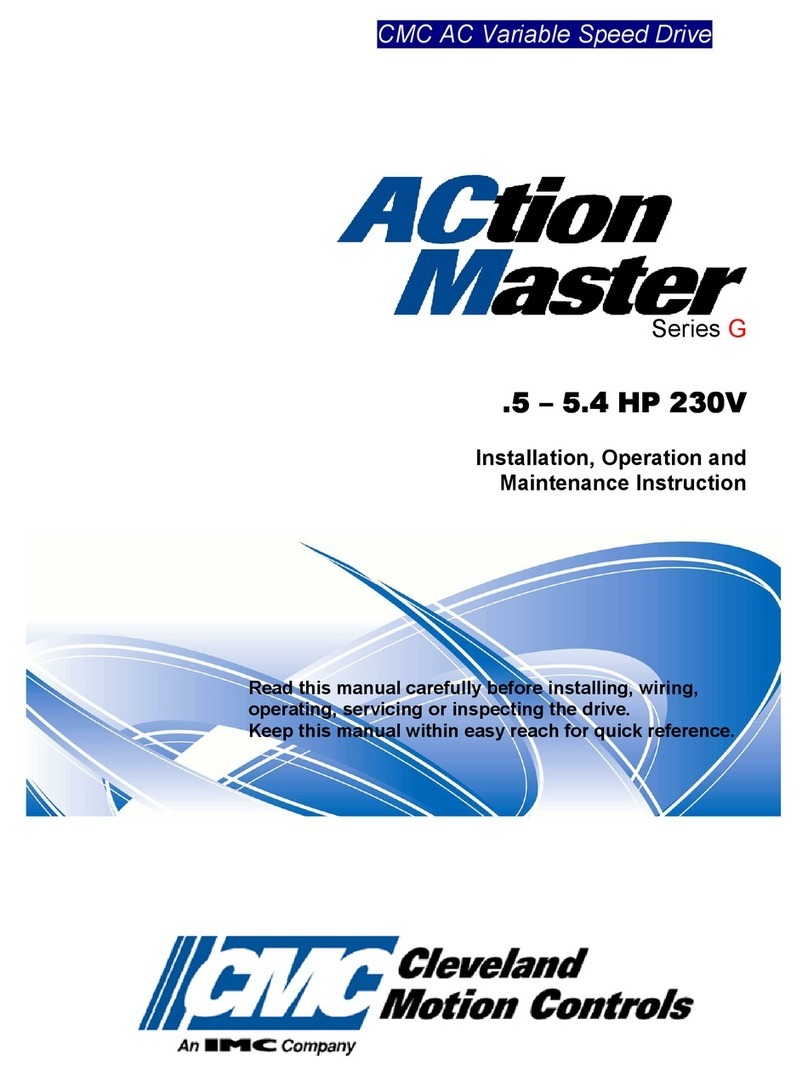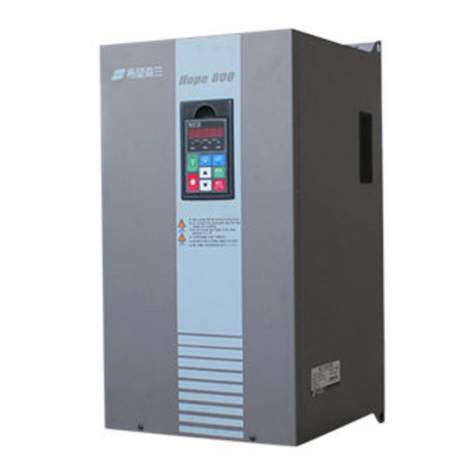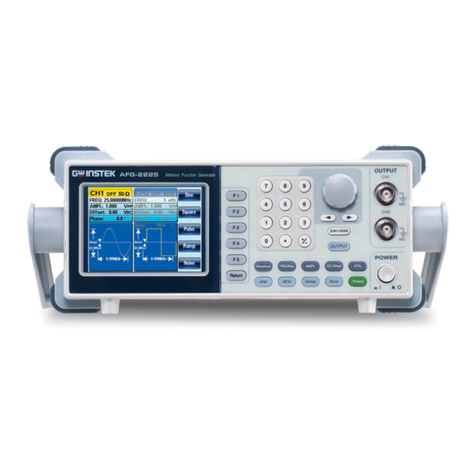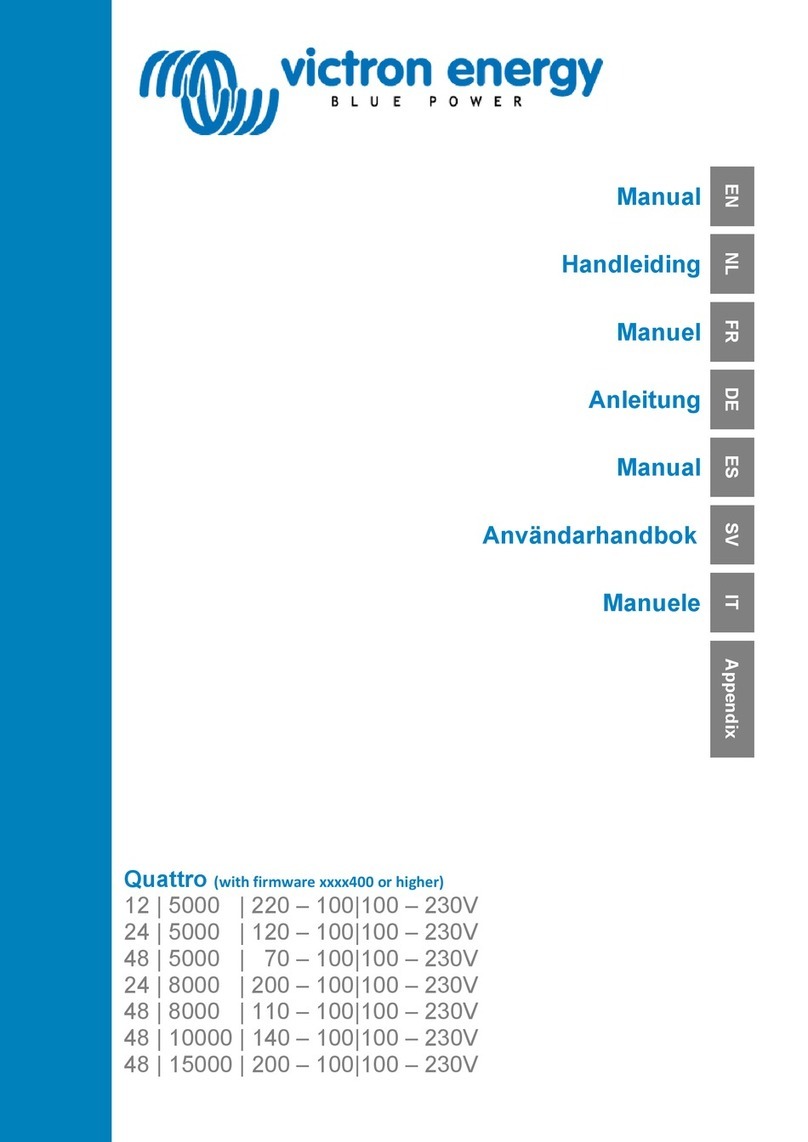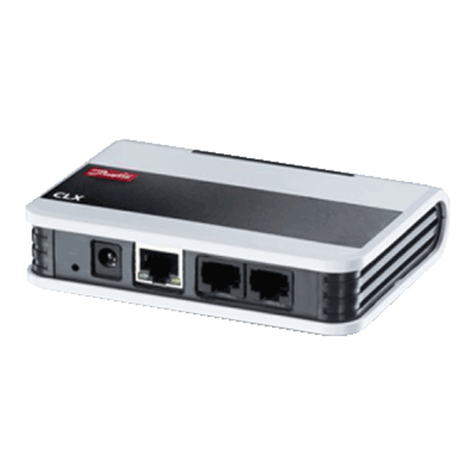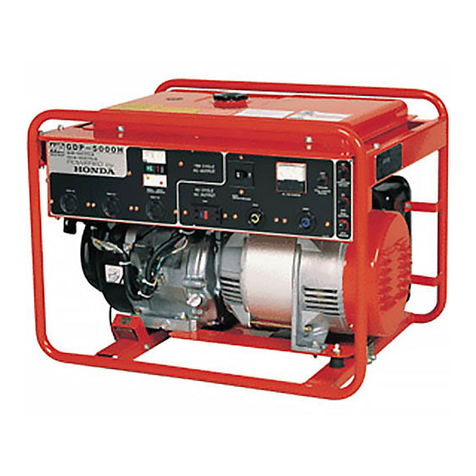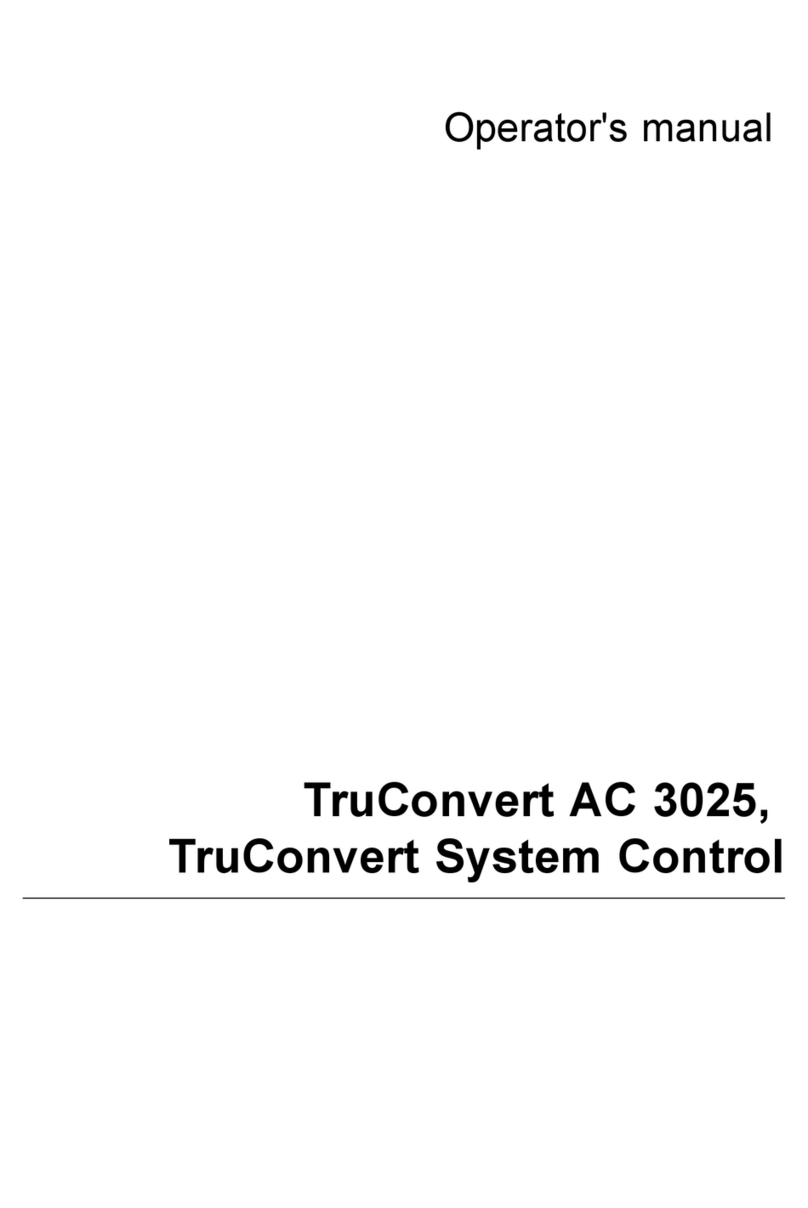MEGAREVO R5KLNA User manual

Hybrid Inverter User Manual
V1.3

1
CONTENTS
1. NOTES ON THIS MANUAL................................................................................................................................. 3
1.1 SCOPE OF VALIDITY....................................................................................................................................... 3
1.2 TARGET GROUP.............................................................................................................................................. 3
1.3 SYMBOLS USED.............................................................................................................................................. 3
2. SAFETY.................................................................................................................................................................... 4
2.1 IMPORTANT SAFETY INSTRUCTIONS ....................................................................................................... 4
2.2 EXPLANATION OF SYMBOL ....................................................................................................................... 8
3. INTRODUCTION ................................................................................................................................................... 9
3.1 BASIC FEATURES ............................................................................................................................................ 9
3.2 SYSTEM DIAGRAM........................................................................................................................................ 9
3.3 WORK MODES ..............................................................................................................................................12
3.4 DIMENSION ...................................................................................................................................................13
3.5 TERMINALS OF PV INVERTER ...................................................................................................................14
4. TECHNICAL PARAMETERS ................................................................................................................................16
4.1 INVERTER SPECICATION ............................................................................................................................. 16
5. INSTALLATION .....................................................................................................................................................18
5.1 CHECK FOR PHYSICAL DAMAGE ..............................................................................................................18
5.2 PACKING LIST ................................................................................................................................................18
5.3 MOUNTING ...................................................................................................................................................18
6. ELECTRICAL CONNECTION ............................................................................................................................ 22
6.1 PV CONNECTION ........................................................................................................................................ 22
6.2 GRID CONNECTION (GEN CONNECTION) .......................................................................................... 23
6.3 BACK-UP:LOAD1 AND LOAD2 CONNECTION...................................................................................... 24
6.4 BATTERY CONNECTION............................................................................................................................ 26
6.5 WIFI CONNECTION (OPTIONAL)............................................................................................................ 28
6.6 GPRS CONNECTION (OPTIONAL).......................................................................................................... 28
6.7 CT INSTALLATION INSTRUCTIONS......................................................................................................... 29
6.8 E-STOP INSTALLATION .............................................................................................................................. 30
7. LCD OPERATION .................................................................................................................................................31
7.1 CONTROL PANEL ..........................................................................................................................................31
7.2 INSTRUCTIONS FOR LED INDICATOR.....................................................................................................31
7.3 INSTRUCTIONS FOR THE USE OF THREE MODES ............................................................................. 32
8. LCD OPERATION ................................................................................................................................................ 35
8.1 LCD INTERFACE ............................................................................................................................................ 35
9. GENERATOR USE OPERATION GUIDE........................................................................................................... 59
9.1 GENERATOR USE DIAGRAM...................................................................................................................... 59

2
9.2 GENERATOR OPERATION NOTES ............................................................................................................61
9.3 GENERATOR SETTING .................................................................................................................................61
10. INVERTER PARALLEL GUIDE........................................................................................................................... 63
10.1 PARALLEL SYSTEM DIAGRAM ................................................................................................................. 63
10.2 PARALLEL COMMUNICATION CABLE CONNECTION...................................................................... 67
10.3 PARALLEL OPERATION NOTES............................................................................................................... 67
10.4 PARALLEL SYSTEM SETTING ................................................................................................................... 68
11. ADVANCED MODE OPERATION GUIDE ..................................................................................................... 69
11.1 ADVANCED MODE INTRODUCTION..................................................................................................... 69
11.2 ADVANCED MODE SETTING................................................................................................................... 70
12. FAULT DIAGNOSIS AND SOLUTIONS.......................................................................................................... 72

3
1 Notes on this
Manual
1.1 Scope of Validity
This manual is an integral part of Hybrid, it describes the assembly, installation,
commissioning, maintenance, and failure type of the product. Please read it
carefully before operating.
Naming rules, For example: R7K6LNA
“7K6、5K” means “output power 7.6kw or 5kw ”.
“L“means “Output single-phase
“NA”means “North America”
Store this manual where it will be always accessible.
1.2 Target Group
This manual is for qualified electricians. The tasks described in this manual only can
be performed by qualified electricians.
1.3 Symbols Used
The following types of safety instructions and general information appear in this
document as described below:
R5KLNA
R6KLNA
R7K6LNA
R8KLNA
R10KLNA
D
anger!
“Danger “indicates a hazardous situation which, if not avoided, will result in
death or serious injury.
Warning!
“Warning “indicates a hazardous situation which, if not avoided, could result
in death or serious injury.
Caution!
“Caution” indicates a hazardous situation which, if not avoided, could result
in minor or moderate injury.
Note!
“Note” provides tips that are valuable for the optimal operation of ours.

4
2
Safety
2.1 Important Safety Instructions
Danger!
⚫Danger to life due to high voltages in the inverter!
⚫All work must be carried out by qualified electrician.
⚫The appliance is not to be used by children or persons with reduced
physical sensory or mental capabilities, or lack of experience and
knowledge, unless they have been given supervision or instruction.
⚫Children should be supervised to ensure that they do not play with
the appliance.
Caution!
⚫Danger of burn injuries due to hot enclosure parts!
⚫During operation, the upper lid of the enclosure and the enclosure
body may become hot.
⚫Only touch the lower enclosure lid during operation.
Caution!
⚫Possible damage to health as a result of the effects of
radiation
!
⚫Do not stay closer than 20 cm to inverter for any length of time.
Warning!
⚫Ensure input DC voltage ≤Max. DC voltage. Over voltage may cause
damage.
⚫Permanent damage to inverter or other losses, which will not be
included in warranty!
Note!
⚫Grounding the PV generator.
⚫Comply with the local requirements for grounding the PV modules and
the PV generator. It is recommends connecting the generator frame
and other electrically conductive surfaces in a manner which ensures
continuous conduction and ground these in order to have optimal
protection of system and persons.

5
Warning!
⚫Authorized service personnel must disconnect both AC and DC power
from inverter before attempting any maintenance or cleaning or
working on any circuits connected to inverter.
Warning
!
⚫Do not operate the inverter when the device is running.
Warning!
⚫Risk of electric shock!
⚫Please keep the user manual properly. When operating equipment, in addition
to following the general precautions in this document, follow the specific safety
instructions. We will not be liable for any consequence caused by the violation
of the safety operation regulations and design, production, and usage
standards.
⚫Accessories only together with the inverter shipment are recommended here.
Other- wise may result in a risk of fire, electric shock, or injury to person.
⚫Make sure that existing wiring is in good condition and that wire is not
undersized. Do not disassemble any parts of inverter which are not mentioned
in installation guide. It contains no user-serviceable parts. See Warranty for
instructions on obtaining service. Attempting to service the inverter yourself
may result in a risk of electric shock or fire and will void your warranty.
⚫Keep away from flammable, explosive materials to avoid fire disaster.
⚫The installation place should be away from humid or corrosive substance.
⚫Authorized service personnel must use insulated tools when installing or
working with this equipment.
⚫Never touch either the positive or negative pole of PV connecting device.
Strictly prohibit touching both at the same time.
⚫The unit contains capacitors that remain charged to a potentially lethal voltage
after the MAINS, battery and PV supply has been disconnected.
⚫Hazardous voltage will present for up to 5 minutes after disconnection from
power supply.
⚫CAUTION-RISK of electric shock from energy stored in capacitor, never operate
on the inverter couplers, the MAINS cables, Battery cables, PV cables or the PV
generator when power is applied. After switching off the PV, battery, and Mains,
always wait for 5minutes to let the intermediate circuit capacitors discharge
before unplugging DC, battery in plug and MAINS couplers.

6
⚫When accessing the internal circuit of inverter, it is very important to wait 5
minutes before operating the power circuit or demounting the electrolyte
capacitors inside the device. Do not open the device beforehand since the
capacitors require time sufficiently discharge!
⚫Surge protection devices (SPDs) for PV installation
WARNING !
⚫Over-voltage protection with surge arresters should be provided when the
PV power system is installed.
⚫The grid connected inverter is not fitted with SPDs in both PV input side
and MAINS side.
⚫Lightning will cause a damage either from a direct strike or from surges due to
a nearby strike.
⚫Induced surges are the most likely cause of lightning damage in majority or
installations, especially in rural areas where electricity is usually provided by
long overhead lines. Surge may be included on both the PV array conduction
and the AC cables leading to the building.
⚫Specialists in lightning protection should be consulted during the end use
application. Using appropriate external lightning protection, the effect of a
direct lightning strike into a building can be mitigated in a controlled way, and
the lightning current can be discharged into the ground.
⚫Installation of SPDs to protect the inverter against mechanical damage and
excessive stress include a surge arrester in case of a building with external
lightning protection system (LPS) when separation distance is kept.
⚫To protect the DC system, surge suppression device (SPD type2) should be
fitted at the inverter end of the DC cabling and at the array located between
the inverter and the PV generator, if the voltage protection level (VP) of the
surge arresters is greater than 1100V, an additional SPD type 3 required for
surge protection for electrical devices.
⚫To protect the AC system, surge suppression devices (SPD type2) should be
fitted at the main incoming point of AC supply (at the consumers cutout),
located between the inverter and the meter/distribution system;
⚫All DC cables should be installed to provide as short a run as possible, and
positive and negative cables of the string or main DC supply should be bundled
together. Avoiding the creation of loops in the system.
⚫Spark gap devices are not suitable to be used in DC circuits once conducting,
they won’t stop conducting until the voltage across their terminals is typically

7
more than 30 volts.
➢Anti-Islanding Effect
Islanding effect is a special phenomenon that grid-connected PV system still supply
power to the nearby grid when the voltage loss is happened in the power system.
It is dangerous for maintenance personnel and the public.
Hybrid series inverter provide Active Frequency Drift (AFD) to prevent islanding
effect.
➢PE Connection and Leakage Current
•The end-use application shall monitor the protective conductor by residual current
operated protective device (RCD) with rated fault current Ifn≤240mA which
automatically disconnects the device in case of a fault.
The device is intended to connect to a PV generator with a capacitance limit
of
approx.
700nf.
WARNING !
⚫High leakage
current!
⚫Earth connection essential before connecting
supply.
Incorrect grounding can cause physical injury, death or equipment malfunction and
increase electromagnetic.
➢Battery Safety Instructions
Hybrid Series inverter should be worked with low voltage battery, for the specific
parameters such as battery type, nominal voltage and nominal capacity etc., please
refer to section 4.3.
As accumulator batteries may contain potential electric shock and short-circuit
current danger, to avoid accidents that might be thus resulted, the following
warnings should be observed during battery replacement:
1: Do not wear watches, rings or similar metallic items.
2: Use insulated tools.
3: Put on rubber shoes and gloves.
4: Do not place metallic tools and similar metallic parts on the batteries.
5: Switch offload connected to the batteries before dismantling battery
connection
terminals.
6: Only personal with proper expertise can carry out the maintenance of
accumulator batteries.

8
2.2 Explanation of Symbol
This section gives an explanation of all the symbols shown on the inverter and on
the type label.
Symbols on the Type Label
UL certified
This symbol indicates that you should wait at least 5mins after disconnecting the
inverter from the utility grid and from the PV panel before touching any inner live
parts.
eep dry! The package/product must be protected from excessive humidity
and must be stored under cover
.
Refer to the operating instructions.
ragile - The package/product should be handled carefully and never
be
tipped over or slung.
Products should not be disposed as household waste.
No more than six(6) identical packages being stacked on each other
Components of the product can be recycled.
Danger of hot surface!
Danger of high voltage and electric shock!
Caution! Failure to observe a warning indicated in this manual may result in injury

9
3. Introduction
3.1 Basic features
Hybrid Series is a high-quality inverter which can convert solar energy to AC energy
and store energy into battery.
The inverter can be used to optimize self-consumption, store in the battery for
future use or feed in to public grid. Work mode depends on PV energy and user’s
preference. It can provide power for emergency use during the grid lost by using
the energy from battery and inverter (generated from PV).
3.2 System Diagram
Hybrid Series is designed with two BACK-UP versions for customer to choose based
on the local rules. The applies to the wiring rules that requires Neutral line of
alternative supply must NOT be isolated or switched.

10
All switches and RCD devices in the figure are for reference only, and the specific
installation shall be subject to local regulations.
Note!
⚫Please control the home loads, and make sure it’s within
the “BACK-UP output rating” under BACK-UP mode,
otherwise the inverter will shut down with an “overload fault”
warning.
⚫Please confirm with the mains grid operator whether there
is any special regulations for grid connection.

11
Note!
⚫The arrow on the CT points to the power grid, as shown.
⚫If the CT connector is improperly connected, the inverter
cannot read the data correctly, so that the relevant working
conditions cannot be realized normally.

12
3.3 Work Modes
Inverter provides multiple work modes based on different requirements.

13
In addition to the above three basic modes, there is also an “Advanced Mode”.
Please refer to Chapter 11 for details.
3.4 Dimension

14
3.5 Terminals of PV inverter
L
* Port Function
CAN1/CAN2: Communication interface for connecting inverters.
RS485: Read the internal data of inverter.
BMS-485/ BMS-CAN: BMS communication for lithium batteries.
CT L1/CT L2: For external grid side CT to detect current size.
TYPE-C UPDATE: Update machine software locally on PC via USB-A port.

15
Object
Description
A
A
DC switch
B
BAT input
C
Wi-Fi
D
CAN1/CAN2/RS485/BMS485,BMSCAN/CTL1/CTL2/Type-c upgrade
E
PV1~PV4 input
F
Generator
G
Grid
H
BACK-UP1 output
I
PE
J
BACK-UP2 output
K
LCD
L
RSD button
WARNING !
Qualified electrician will be required for the

16
4. Technical Parameters
4.1 Inverter specication
Technical Data
R5KLNA
R6KLNA
R7K6LNA
R8KLNA
R10KLNA
PV Input Data
MAX.DC Input Power
7.5kW
9kw
12kw
12KW
15kW
NO.MPPT Tracker
4
MPPT Range
120 - 500V
MAX.DC Input Voltage
500V
MAX.Input Current
12A
Battery Input Data
Nominal voltage (Vdc)
48V
48V
48V
48V
48V
MAX.Charging/Discharging Current
120A/120A
135A/135A
190A/190A
190A/190A
210A/210A
Battery Voltage Range
40-60V
Battery Type
Lithium and Lead Acid Battery
Charging Strategy for Li-Ion Battery
Self-adaption to BMS
AC Output Data(On-Grid)
Nominal output power Output to Grid
5kVA
6kVA
7.6kVA
8kVA
10kVA
MAX. Apparent Power Output to Grid
5.5kVA
6.6kVA
8.4kVA
8.8kVA
11kVA
Output Voltage Range
110-120/220-240V split phase, 1Ø, 230 1 phase
Output Frequency
50/60Hz(45 to 54.9Hz / 55 to 65Hz)
Nominal AC Current Output to Grid
20.8A
25A
31.7A
33.3A
41.7A
Max.AC Current Output to Grid
22.9A
27.5A
35A
36.7A
45.8A
Output Power Factor
0.8leading…0.8lagging
OutPut THDI
< 2%
AC Output Data(Back-Up)
Nominal. Apparent Power Output
5kVA
6kVA
7.6kVA
8kVA
10kVA
MAX. Apparent Power Output
5.5kVA
6.6kVA
8.4kVA
8.8kVA
11kVA
Nominal Output Voltage L-N/L1-L2
120/240V
Nominal Output Frequency
60Hz
Output THDU
< 2%
Efficiency
Europe Efficiency
>=97.8%
MAX. Battery to Load Efficiency
>=97.2%
Protection
Grounding detection
YES
Arc Fault Protection
YES
Island Protection
YES
Battery reverse Polarity
YES

17
Insulation Resistor Detection
YES
Residual Current Monitoring Unit
YES
Output Over Current Protection
YES
Back-up Output Short Protection
YES
Terminal temperature detection
YES
Output Over Voltage Protection
YES
Output Under Voltage Protection
YES
General Data
Output Conduit
25.4mm
PV Input Conduit
25.4mm
BAT Input Conduit
34.5mm
Operating Temperature Range
-25 ~ +60°C
Relative Humidity
0-95%
Operating Altitude
0~4000m
Ingress Protection
IP65/NEMA 3R
Weight
41kg
Size (Width*Height*Depth)
430mm x 710mm x 225mm
Cooling
Natural Convection
Noise emission
<38dB
Display
LCD
Communication With BMS/Meter/EMS
RS485,CAN
Supported communication interface
RS485, WLAN, 4G (optional)
Self-consumption at night
< 2.5 W (with battery enabling < 5 W)
Safety
UL1741SA all options, UL1699B, CSA 22.2
EMC
FCC Part 15 Class
Grid connection standards
IEEE 1547, IEEE 2030.5, Hawaii Rule 14H, Rule 21 Phase I,II,III

18
5.
Installation
5.1 Check for Physical Damage
Make sure the inverter is intact during transportation. If there is any visible damage,
such as cracks, please contact your dealer immediately.
5.2 Packing List
Open the package and take out the product, please check the accessoriesfirst .The
packing list shown as below.
A B C
D E F G
5.3 Mounting
➢Installation Precaution
Inverter is designed for outdoor installation (IP 65).Make sure the installation
Object
Description
A
Inverter
B
Expansion screws and pan-head screws
C
CT( inner radius 16mm)
D
GPRS module (optional)
E
WiFi module (optional)
F
User manual
G
CT(inner radius 35mm/optional)

19
site meets the following conditions:
◆Not in direct sunlight.
◆Not in areas where highly Flammable materials are stored.
◆Not in potential explosive areas.
◆Not in the cool air directly.
◆Not near the television antenna or antenna cable.
◆Not higher than altitude of about 2000m above sea level.
◆Not in environment of precipitation or humidity (>95%).
◆Under good ventilation condition.
◆The ambient temperature in the range of -20℃ to +60℃.
◆The slope of the wall should be within ± 5° .
◆The wall hanging the inverter should meet conditions
below:
1.solid brick/concrete, or strength equivalent mounting surface;
2.Inverter must be supported or strengthened if the wall’s strength isn’t
enough(such as wooden wall, the wall covered by thick layer of decoration)
Please AVOIDE direct sunlight, rain exposure, snow laying up during installation
and operation.
This manual suits for next models
4
Table of contents
Other MEGAREVO Inverter manuals
